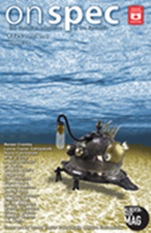 On Spec #125, Fall 2023
On Spec #125, Fall 2023
“A Fairytale for Sofie” by Antony Paschos
“Oh Exemplary Restraint, So Rare in the Modern World!” by R. Keelan
“The Chameleon” by Pascal Raud
“The Trombone, the Pianist, the Four-Wheeler, and the Zombies” by Carolyn Watson
“The Written Future” by A. J. Wells
“Alien Anthropologist” by A. Reid Johnson
“The Keening of a Sparrow” by Lorina Stephens
“Folklore” by Brenda Tremayne
“And if Venice is Sinking” by Fiona Moore
Reviewed by Victoria Silverwolf
Seven original works of fiction and two newly translated stories appear in this issue.
“A Fairytale for Sofie” by Antony Paschos is translated from Greek, presumably by the author. The young daughter of a dying woman is obsessed with a virtual reality game, claiming that it will allow her to save her mother’s life. Her hope continues even after the mother is dead.
Just from this brief synopsis, readers may be able to predict the conclusion. The story is obviously intended to be a tearjerker, and it achieves that goal. The Greek setting adds a touch of interest for readers outside that culture.
The narrator of “Oh Exemplary Restraint, So Rare in the Modern World!” by R. Keelan is a homeless woman hired by a scholar to digitize monster stories. The scholar turns out to be something other than expected.
Again, even a brief, vague synopsis can provide enough of a hint that readers should be able to predict where the story is going. Although the plot is not surprising, the narrator’s no-nonsense, hardboiled attitude provides a certain amount of enjoyment.
“The Chameleon” by Pascal Raud is translated from French by Margaret Sankey. The narrator uses a time machine in the form of a watch to enter a magical realm where a child can change sex on a whim and ride a giant rat, and where people from many different times and places dwell.
There is little to this whimsical tale other than the premise and a detailed description of the enchanted land and its inhabitants. Readers seeking charming narration rather than plot will best appreciate it.
In “The Trombone, the Pianist, the Four-Wheeler, and the Zombies” by Carolyn Watson, three elderly people face an invasion by hordes of flesh-eating undead in their own way.
Cannibalistic zombies are a very familiar horror premise, which has been used to death (pun intended.) This example of a clichéd concept is notable for its feisty protagonists and sardonic humor.
“The Written Future” by A. J. Wells is a surreal tale that is difficult to describe. If I understand the premise correctly, Earth has been taken over by an apparently sentient ink from another world. The narrator is one of the people who serve the ink by recording their memories. The arrival of an ex-lover changes the situation greatly.
The story is certainly original and has a great deal of atmosphere. Those who enjoy the bizarre, even if it is not always clear, are the best audience for this strange work of weird fiction.
“Alien Anthropologist” by A. Reid Johnson is a brief story in which the narrator warns a supervisor about the danger of contacting an extraterrestrial representative without proper precautions. Of course, the superior ignores this advice and pays the consequences.
As I have tried to indicate, the plot is simple and predictable. The supervisor is a stereotype of an arrogant bureaucrat, and his foolish actions make the reader wonder how he obtained a position of authority.
Only two pages long, “The Keening of a Sparrow” by Lorina Stephens is an introspective, psychological portrait of a physician struggling to save the life of an injured bird aboard a spaceship in the asteroid belt. Not everything is as it seems to be.
This story is a rare example of second person narration, currently popular in speculative literature, used appropriately. Without giving too much away, the technique of addressing the reader directly adds to the impact of this quietly disturbing science fiction story.
The narrator of “Folklore” by Brenda Tremayne is a scholar investigating tales of the supernatural in a Portuguese village. She discovers more than she expected to find.
The story feels like an old-fashioned Gothic horror movie, and fans of such films will be able to anticipate much of what happens. The setting adds a fair amount of local color.
In “And if Venice is Sinking” by Fiona Moore, virtual reality tourism is somehow able to cause physical damage to sites that people visit through VR. The narrator’s lover suggests a plan where exact virtual duplicates of famous tourist sites could be created; these replicas would not be harmed by VR visitors. The lover has a secret motive, and the narrator reacts to it in an unexpected way.
The premise is interesting, if implausible and slightly confusing. Perhaps the most intriguing thing about this story is its futuristic background with constant use of VR, resulting in a society in which people can be lovers for years without meeting or even knowing each other’s gender.
Victoria Silverwolf is a fan of old-fashioned Gothic horror movies.